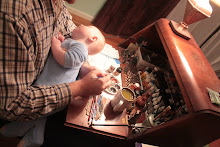Thursday, February 16, 2012
Monster Manual, 4th Edition
No, not Type IV 4th edition, 4th edition of the original Advanced Dungeons and Dragons Monster Manual, published when I was but a year old. Thanks to the miracles of intra-library loans, I have been looking through it this week. I was pretty excited to get it, since I have never read any of the original AD&D material, instead having first come into the hobby with 2nd Edition, and mostly with modern retro-clones like Labyrinth Lord.
The presentation in this book is fairly standard, in that it has a stat block, description of the creature and its abilities, any special notes about occurrence etc, and occasionally a picture. Surprising to me at least, was that the stat block does not have any XP information. Some groups of like monsters are grouped together, so that "devils", "dinos", and "demons" can have their general rules explained up front. (although this is not true for "undead" or "pre-historic" for example). Another interesting aspect is that monster damage is not mentioned in terms of dice types (d4-d20), but rather as damage ranges. This is probably due to the lack of polyhedral dice at the time, but it does make for a bit of extra work to convert 2-8 to 2d4 say, and some of the damage ranges do not convert nicely in to dice types.
The art in the book is... variable. The pieces by D.A. Trampier are generally good to excellent (in particular the Were-rats and Rakshasa), where as the majority of pieces by D.C. Sutherland III are... poor (dragons in particular). They do generally convey the idea of the creature though, and fit the sort of pseudo-late medieval milieu that Gygax seems to have run his games in, and they have a sort of enthusiastic nature that makes some of them charming.
An interesting aspect is that the last couple pages of the book are a catalog of all TSR Fantasy and Science Fiction games available at the time, which reminds you that there were briefly at least, THREE versions of D&D in print at the same time. (AD&D, Basic, and Original). There is also an advertisement for GenCon, then owned by TSR.
Compared to modern works, the 1979 book is hardly state of the art. If someone published this now, you would consider it "amateur" and probably would not pay more than $5 for a PDF copy. Desktop publishing has advanced significantly in the last 10 years, never mind in the last 30. Yet, it is pretty easy to see how this would have been revolutionary at the time it was first published, in particular as an advancement on small stapled booklets. If you have not checked it out, you should, just to see how far things have come.
Yesterday I got the original AD&D DM's guide, also from intra-library loan, so I am pretty excited to read that next.
Subscribe to:
Post Comments (Atom)



3 comments:
There were plenty of polyhedral dice back in the day. Its been years since I looked at this book - don't even remember why ranges would be 2-8 rather than include the d. If some of the ranges don't convert, they might be something like 3-10 or 1d8+2. You'll find the xp charts in the back of the DMG.
I find it amazing that your library system still has a copy after all these years. ADD was the foundation for all of my role playing.. I still have a fondness for all these old books.
"The presentation in this book is fairly standard"
Well, it kind of set the standard, didn't it? :)
I remember scratching my head over some of the odder ranges of numbers. I don't know when the whole XdX code was introduced, but it is remotely possible that simply no-one was doing it.
OD&D had 100 x HD = XP (200 x HD for things with special powers), which was replaced in the first supplement with a much lower standard, but I am guessing it wasn't in the MM because it hadn't been decided. Your later edition probably only had egregious errors fixed; changing the printing plates was a big deal in the 70s and early 80s...adding XP after the DMG came out would have been too expensive!
CTF:
I had assumed that since chits were included for use as dice in early D&D boxed sets, that the dice were not easily available.
OUr library has an amazing collection of mostly 3.5 edition materials, but this particular item came from an interlibrary loan... as I recall it was from a college.
Mike:
Yes, of course this book set the standard for RPG suppliments, although one could also argue that it was a fairly standard "encylopedia" sort of entry. In any case, following books certainly used this style.
A list of errata changed from edition to edition would certainly have been interesting... one could then see what were typos and what were
Post a Comment